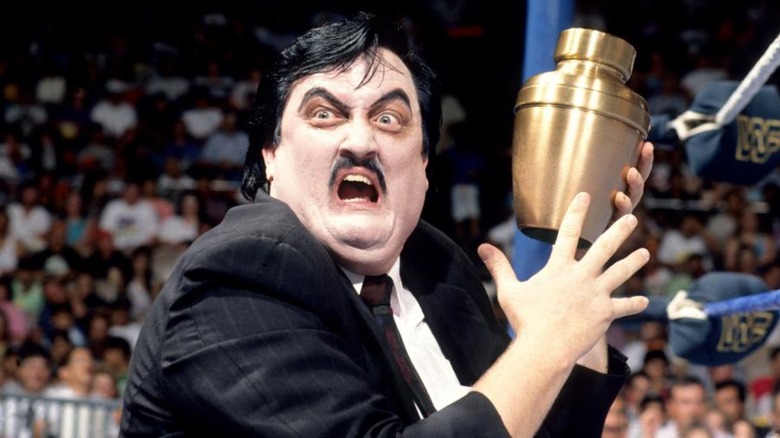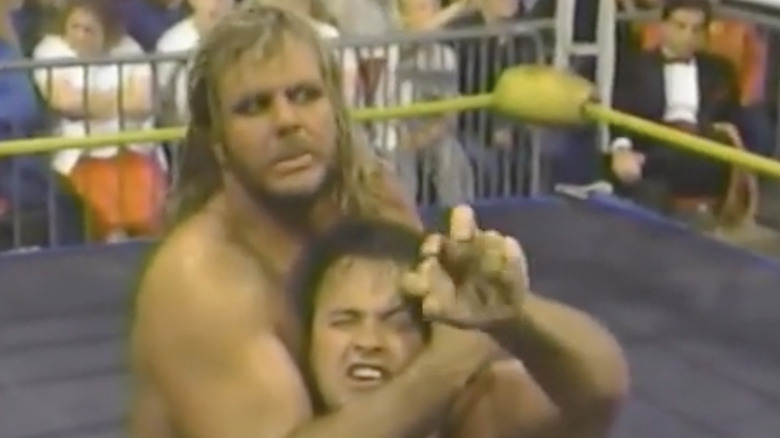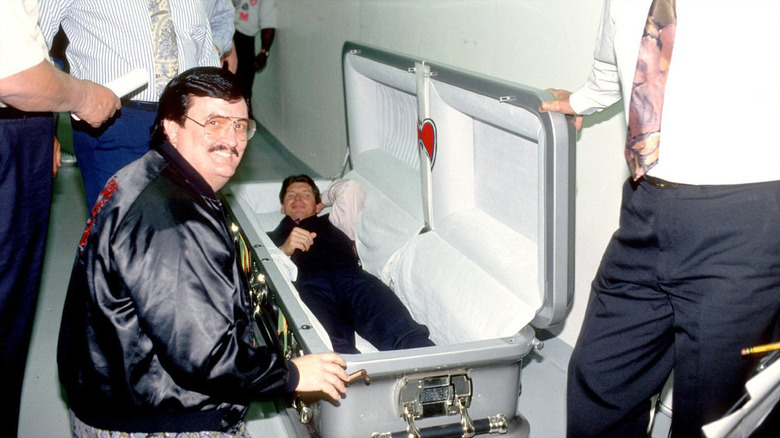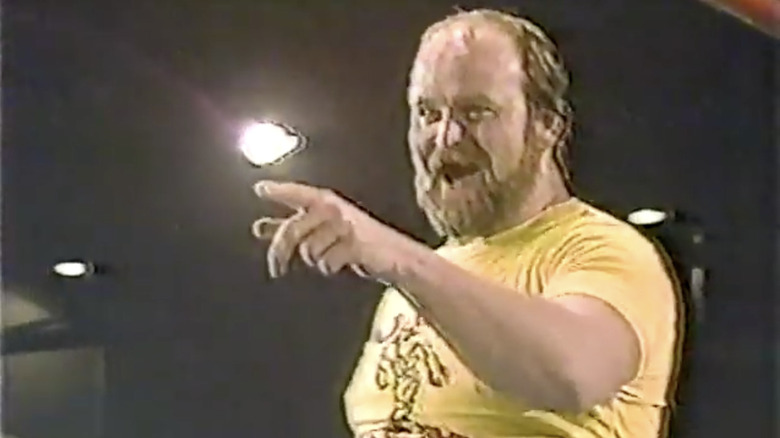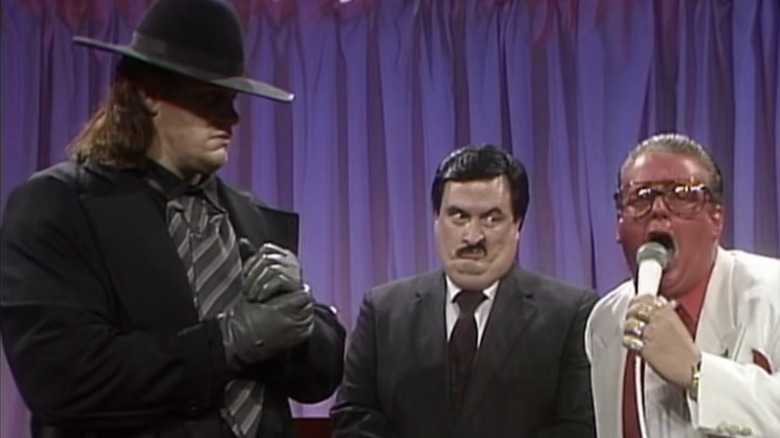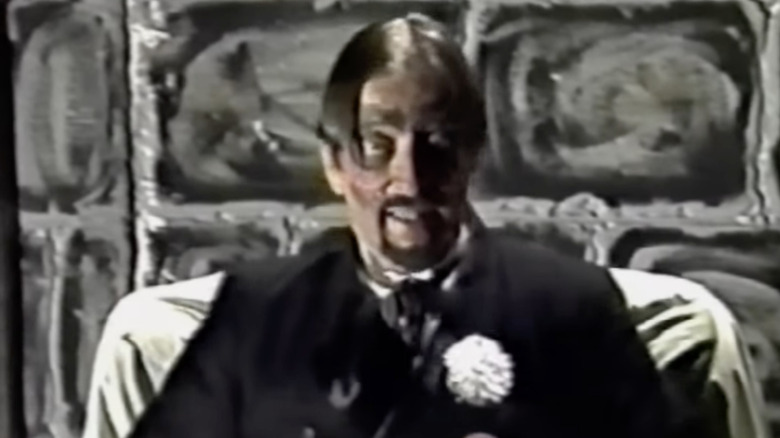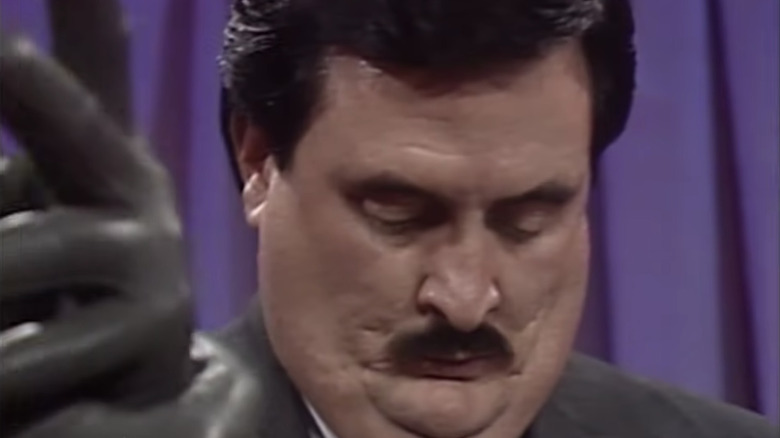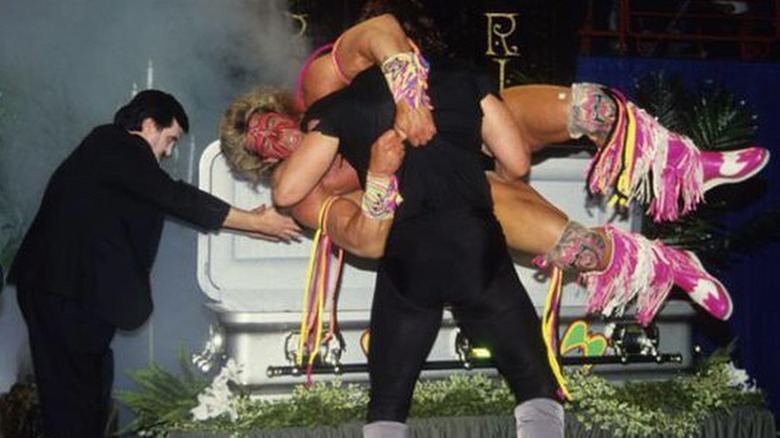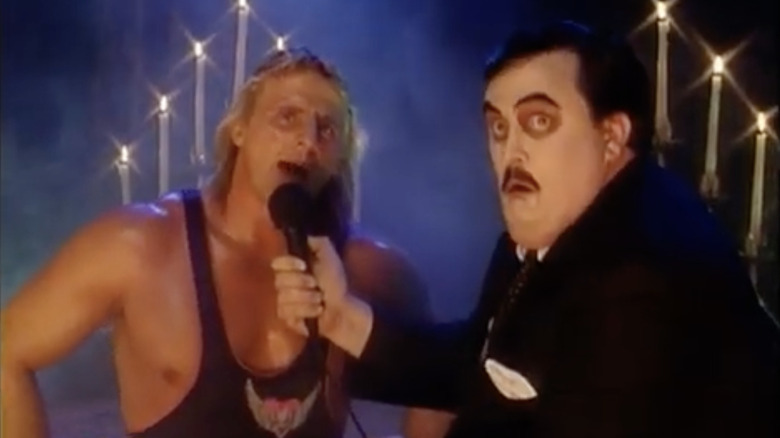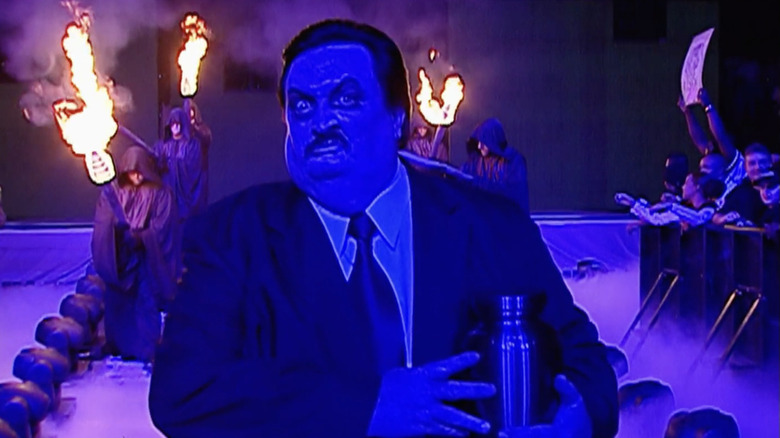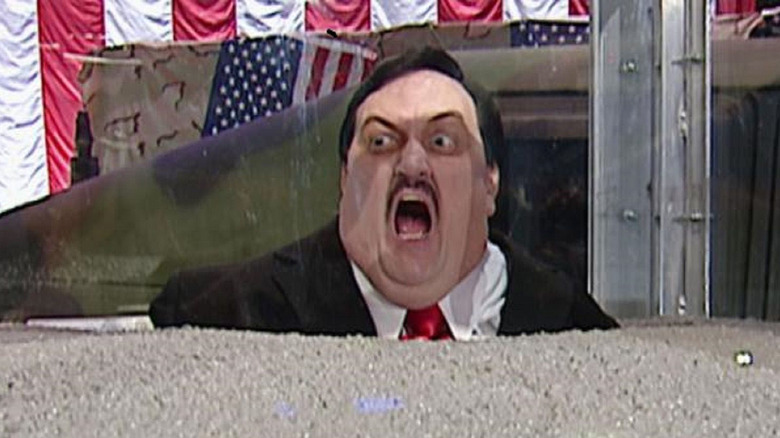Paul Bearer: Facts Only Hardcore Fans Know About The Legendary Manager
When the man behind the Paul Bearer gimmick, William Moody, passed away on March 5, 2013, the reaction was almost a referendum on the impact that the character had. At a time when such a thing was less common than it is now when a pro wrestling star dies, there was a deluge of mainstream media coverage, with even likes of the New York Times and National Public Radio publishing obituaries for Moody. "It really speaks to the uniqueness of the character and how well remembered the Undertaker/Paul Bearer pairing was," wrote Dave Meltzer in the March 19, 2013 issue of the Wrestling Observer Newsletter. "[E]ven people who weren't wrestling fans kind of knew there was a wrestler named The Undertaker who had a manager named Paul Bearer."
Previously known as Percy Pringle III, a spoiled rich kid character of sorts, Moody was well-liked by those who worked with him, making as big an impact on them as he did on the fans. There was a lot more to the guy than the makeup and the high-pitched promos, so let's dive into that.
He and his friends who he went to wrestling shows with all got into the business
When pro wrestling was a regional and closed-off business with very few schools around, the easiest ways to try to break into the business were to hang around shows and try to get on the ring crew for your local promotion or get involved as a photographer. That's what William Moody did before he ever became Percy Pringle III or Paul Bearer, back when he was a teenager in Mobile, Alabama. What makes his story unique, though, is who his fellow hangers-on were, as they all broke into pro wrestling as performers and most became big names.
Joining Moody in Mobile as well as nearby Pensacola, Florida were Michael Seitz (the future Michael "P.S." Hayes of the Fabulous Freebirds), Ruben Kane (the future Robert Gibson of the Rock 'n' Roll express), and John Frenkle (the future "Hollywood" John Tatum). "Although Robert was younger than all of us, we would all kiss his butt because his brother Ricky was already a wrestler," Moody wrote in an old column on his website. "So, we were Ricky Gibson's little brother's buddies, which really made us special. It always seemed to be a contest to see which one of us would make it into the business first. Hayes used to hang out in the arena parking lot, and carry Mike Boyette's bags in for him."
Hayes "got the first call" and became a referee, but before long, all of them had gotten started in the wrestling business.
He really was a mortician
Paul Bearer was no gimmick. Well, it was, but there was part of it that wasn't: The man behind it, William Moody, was a licensed mortician with a degree in mortuary science from San Antonio College. As is laid out on his official website, he became interested in the field when he was working as an emergency medical technician, as he was also transporting dead bodies for funeral homes to make extra money on the side. In 1979, when he and his wife, Dianna, had their first son, Michael, Moody came to a realization: He wasn't going to make enough money to support his family on the local wrestling scene as Percy Pringle III, so he decided to go back to school, get his degree, and pursue work in the funeral industry.
He went back to wrestling in 1984, keeping his mortician's license active throughout his time back in the business. In 1990, when the WWF brought him in for an interview with the intent of hiring him, this bit of trivia about his life suddenly became particularly pertinent.
"We were sitting there talking and I didn't even know that Vince was looking for a manager for the Undertaker," Moody told THQ.com in 2012 in an interview to promote the "WWE '13" video game. "He looks at my resume and he looks over at JJ and Pat Patterson and says 'Do y'all know that he's a real mortician?' Everyone in the room started laughing. "So that moment there when we all realized that they were looking for a manager for 'Taker and that I was a real mortician ... It was a moment in time that I will never forget and I will take to my grave with me."
He wasn't the first Percy Pringle in pro wrestling
Also not quite as much of a gimmick as you'd think? The "Percy Pringle III" name, as, even though William Moody didn't know it when he picked it, he was legitimately the third man in pro wrestling to use "Percy Pringle" as his gimmick name. His official website even has a page laying out the history to try to make the situation less confusing.
The first Percy Pringle was Dennis Forsland, a Canadian wrestler, was the first Percival Pringle, teaming with John Thompson as his brother, "Chauncey Pringle." In a September 1960 Benton Harbor Herald-Palladium article promoting his debut in the Michigan territory against Don Jardine (better known later as The Spoiler), there's a quote that gives you an idea of what kind of heel character he was. "I have been a main event wrestler for five years on the west coast, and don't like wrestling preliminary boys," he's quoted as barking at the promoter when he "signed" for the match. "I will take this one bout and then I want top billing."
The second Percy Pringle — the one you can find in 1970s results that predate Moody — was the future "No Class" Bobby Bass, who saw success in Canadian territories and as part of the Bass Brothers tag teams. In an interview with the Pro Wrestling Historical Society website, Bass noted that he was working in Kansas City as Pringle when Ron Bass, working in Florida, broke his leg, opening up a spot for a new "brother," and the rest was history.
And so by the time Moody broke into wrestling in Mobile, the field had been cleared.
He came to the WWF because Bruce Prichard was given an ultimatum
If you watch The Undertaker's official WWF debut at Survivor Series 1990 and were not a fan at the time, one part of the act sticks out like a sore thumb: 'Taker's manager was Bruce Prichard as Brother Love, not Bill Moody as Paul Bearer. After all, early Undertaker was scary, especially compared to what the usual WWF villains looked like in that era. Brother Love, well, wasn't. He was a comedic heel character. In their earliest promo segments together, they come off as badly mismatched, though Prichard would tweak the persona in the coming weeks with a much more serious version of the character.
Before long, it was moot, though.
"I worked behind the scenes, and I was in [the] studio producing the television shows at that time," Pritchard told Wrestling Inc. in 2018. "And, I was given a choice. Here's the deal: Undertaker, we debuted him, it was my idea to manage him. I brought him in, did this whole thing about how I wanted to bring him in, who I wanted him to be, and I wanted to manage him. I saw it as a television character, the Undertaker as an attraction became such a strong attraction in house shows, that Vince [McMahon] felt him going alone in house shows, you're only getting half of the package if I'm not there. So he said, you need to decide. You're either gonna be a talent and manage the Undertaker, and that means you're gonna be on the road traveling making all the same dates he does, or you can be back in the studio, and do your television duties. I chose to stay back in the studio and do my television duties." This is how Bearer got his opening.
The name Paul Bearer came from a horror movie host in Florida
Though the name "Paul Bearer" sounds like a typically punny creation of Vince McMahon or his "creative services" team, that's not the case. "The name Paul Bearer came from a character played by Dick Bennick Sr., as the host of the local 'Creature Feature' scary movie show on WTOG-TV, in Tampa/St. Petersburg every Saturday afternoon that was popular when [William] Moody lived in Tampa during his time with Championship Wrestling from Florida," wrote Dave Meltzer in his obituary for Moody in the March 12, 2013 issue of the Wrestling Observer Newsletter. "Bennick Sr., the host of the show, was a local television institution, using the name Dr. Paul Bearer, from the mid-'60s until his death in 1995."
Moody's official website appears to corroborate this with a pointed mention of Bennick's character. The week after publishing the obituary, Meltzer added that the "official" version shared by Bruce Prichard is that Road Warrior Hawk came up with the name while on the toilet, but with so many wrestlers living in Tampa at the time Moody was hired. Since Prichard's other story of a Hawk creative epiphany (coming up with the Doink the Clown gimmick) has always seemed apocryphal with the timeline not matching up, it seems reasonable to treat the Hawk/Bearer story as similarly thin.
The Paul Bearer gimmick was a lot different when it debuted
When you think of Paul Bearer, you probably think of two things: His over the top, high-pitched promos about "my Undertaker" that usually ended with an even higher-pitched "OH YES!" as well as the pale white makeup contrasting his jet black dyed hair and mustache. Particularly as a babyface, he was a cartoony accessory to The Undertaker, albeit a very memorable and effective one. That's not how the character started, though.
In his debut on "The Brother Love Show," Bearer barely talks, but the pale makeup is either subtle or nonexistent while he takes a more somber tone. In the first edition of his "Funeral Parlor" talk show segment, Bearer adds more of his trademark bug-eyed facial expressions that he also used as Percy Pringle, but he's still much more reserved and fitting of the role of The Undertaker's manager. The pale white makeup took a great hold around this time, but even in the context of a comedy skit on "Prime Time Wrestling" where he demonstrated the embalming process, he's still a much more reserved version of Paul Bearer.
It took some time for the persona we know to blossom, but it was in full bloom by the time of The Undertaker's brief first WWF Championship reign in November-December 1991. A few months later, The Undertaker would turn babyface, and the shrieking Bearer was a perfect fit for that, making him a lot less scary.
He was part of the first attempted murder angle in WWF history
The Undertaker and Paul Bearer trapping The Ultimate Warrior in a casket on the set of "The Funeral Parlor" on the episode of "WWF Superstars" that aired the weekend of April 13, 1991 is one of the most memorable angles of the era. It was played completely straight, making it a much more scary, violent angle than the usual WWF fare in that era, setting the tone for a year that would include things like Jake Roberts siccing a live cobra on Randy Savage to chew on his arm. So what exactly is such a memorable angle doing in a "facts only hardcore fans know" article? The specifics of the angle being largely forgotten over the years.
It's made clear throughout that the casket is airtight and someone needs to break the seal to save Warrior. When they finally get it open, they see that Warrior had torn through the lining of the casket trying to get out ... and that he's not breathing. He's soon revived via mouth-to-mouth resuscitation, but as someone who lives in the real world now as a grown adult, you've probably realized where this is going. Though nobody ever outright says it during the angle, Warrior is apparently clinically dead as a result of the attack, and even if you don't want to go that far, locking someone in an airtight box without oxygen is clearly attempted murder. And though there would be more and more outlandish angles in the future like, say, deliberately hitting another wrestler with a car, this was the first time that a WWF wrestler outright tried to kill a rival in canon.
The Funeral Parlor was brought back to give him a presence on WWF TV during The Undertaker's first hiatus
Less well-received is the angle that wrote The Undertaker off WWF programming for eight months in 1994, when he was seemingly killed off at Royal Rumble 1994 and ascended to the heavens. If you were a fan at the time, you probably remember Paul Bearer disappearing from TV for much of the interim, returning when the storyline with Ted DiBiase's fake Undertaker started in late May. You probably also remember Bearer's Funeral Parlor talk show segment being more or less done after he and The Undertaker turned babyface in early 1992. But that's not exactly what happened.
On the February 19 and March 5, 1994 episodes of "WWF Superstars," taped on February 1, The Funeral Parlor returned, with Yokozuna, Jim Cornette, and Lex Luger being the guests in the first segment and Owen Hart being the guest in the second. These were the first Funeral Parlor segments on Superstars in about two years and the first period since one that aired on the November 14, 1992 "Saturday Night's Main Event" special. On top of that, the previous "Superstars" installment two years earlier was the only previous time where Bearer, as a babyface, had interviewed a heel (Jake Roberts). So seemingly to keep the character alive on TV while The Undertaker was gone and have a babyface talk show segment, fans witnessed the awkward display that was Bearer doing his entire shtick while asking earnest questions about things like Owen Hart betraying his brother, Bret. And that was the end of Paul Bearer for the next few months.
WWE paid for his gastric bypass surgery
In October 2002, by way of what he described on his website as a mutual agreement, William Moody left WWE. Paul Bearer had already been off TV as a character for over two years, with Moody working behind the scenes as a producer and talent scout in the meantime. "As 2003 began, I practically accepted the fact that I would never actively return to the ring," Moody wrote. "As the months went slowly by and my weight increased, I knew that no wrestling company would ever have any interest in using me again." In September, though, WWE reached out about "a possible idea for you." Depressed and knowing that his health was such he couldn't go on the road, he initially declined, but the came clean after the WWE official reaching out realized something was wrong and asked what the company could do to help him.
With the "idea," The Undertaker switching back from his biker persona to a variation of the "Deadman" gimmick, needing Paul Bearer to work as well as possible, WWE signed him while agreeing to pay for gastric bypass surgery.
"We knew that we wanted to bring The Undertaker back in the original incarnation and to do that without Paul Bearer was going to be really challenging," then-head of talent relations Jim Ross explained on his podcast (transcription h/t Fightful). "We wanted to put that package back together and in order to do so, we had to take some medical steps to make sure that Paul Bearer was as healthy as he could be."
The Undertaker killing him in 2004 leaked before the PPV that day
Just a few months after Paul Bearer's 2004 return, he was seemingly "killed off" as part of a convoluted storyline where Paul Heyman held him hostage in a glass case where he was to be slowly being buried alive in cement. This came to a head at Great American Bash 2004, where, for some reason, The Undertaker, still acting as a babyface, elected to pull the lever on the cement mixer that would cause it to fill the "crypt" and shuffle Bearer off this mortal coil.
And if you were following wrestling news on the internet the day of the pay-per-view event in question, you likely got spoiled as to the ending, and maybe even saw a glimpse of it. Back in the day, it was easier for owners of specific types of satellite dishes to pick up things that were not meant for public consumption if there was no real effort made to encrypt them. One of those intercepted "wildfeeds" was what was either the rehearsal of the climax of the 2004 Bash show or a pre-recording of the close-ups of Bearer. (It was reported in the July 5 issue of the Wrestling Observer Newsletter that those were partially pre-taped so a stuntman could be in the box live, which Bruce Prichard later corroborated on his podcast.) You can watch it on YouTube if you want to. Let's never speak of it again.
